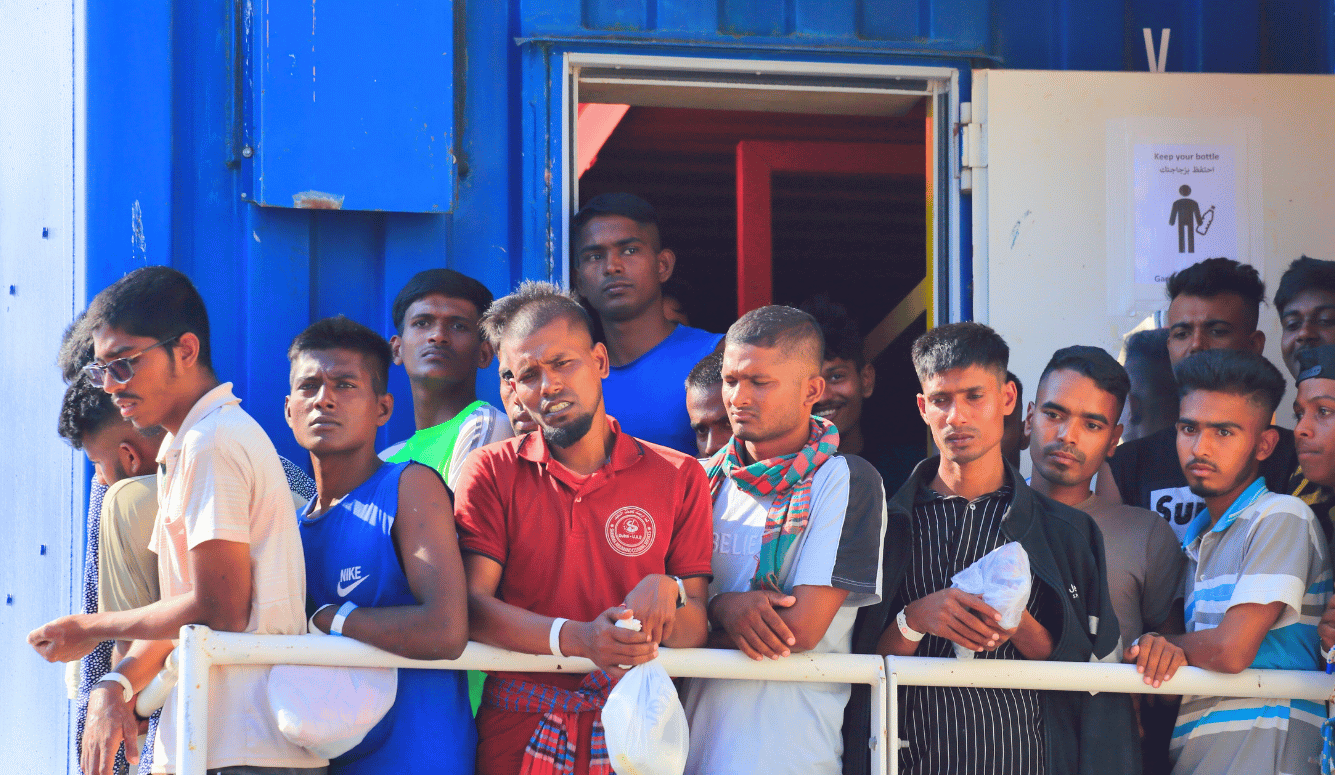A Rose-Tinted View of Immigration
Hein de Haas’s new book has been billed as a balanced, fact-based approach to the immigration debate. In fact, it is just another Pollyannaish pro-immigration polemic.

A Review of How Migration Really Works: 22 Things You Need to Know About the Most Divisive Issue in Politics by Hein de Haas, 464 pages, Penguin (August 2024).
Few topics divide Western societies today as sharply as immigration. The optimists, often associated with the Left, view it primarily as enriching, while the pessimists, usually linked to the Right, perceive it as primarily threatening. This longstanding conflict has been threatening to spiral out of control. There is a real need for a book that provides the basis for a substantive and—as far as such a thing is possible—objective and even-handed debate. This is the book migration expert Hein de Haas claims to have written, based on thirty years of research. Unfortunately, he has failed to deliver.
Haas’s central argument is that migration is a “normal process,” which does not warrant panic. The message has struck a chord. The Guardian describes the book as a “powerful debunking of myths” and “a clear and rigorous corrective.” The Times Literary Supplement calls it “a brave venture,” which “resolutely trashes the assumptions both the left and the right use to prop up their belief systems.” The prestigious Frankfurter Allgemeine Zeitung thinks it a “fascinatingly told work” that “offends both left-liberals and conservatives equally.” In Haas’s native country of the Netherlands, the responses have almost been adulatory. “What was the Eureka moment?,” major Dutch newspaper NRC asked the professor. The book has already gone through many print editions and has been translated into numerous languages.
But the evidence De Haas provides is often weak and far from being an apolitical, purely factual account, the work is an overly simplistic, one-sided narrative that is ideologically aligned with the immigration optimism of the Left.

The book is not without merit. It is clearly and accessibly written and packed with relevant research findings. De Haas is at his strongest when emphasising that demand for labour often drives migration. People often leave their countries of origin in search of better salaries elsewhere. As De Haas points out, in many such cases, multiple actors benefit economically from this: the migrants; their countries of origin (because they send remittances); their employers; and consumers, who get cheaper services—since, De Haas argues, Western societies cannot pay early retirement pensions, maximise economic growth, and provide cheap services if they drastically limit immigration.
As De Haas points out, this presents a dilemma for the Right. Right-wing parties often present themselves as hardliners on immigration, but in practice, most right-wing parties continue to permit high levels of immigration because of the economic interests involved and the influence of powerful employer lobbies. De Haas maintains that the wealthy reap more of the benefits of immigration, while the poor bear more of the costs. I would argue that this can push disappointed working-class voters, who want a more restrictive policy, towards more radical and far-right parties.
Yet the book’s central theme is that we should not worry unduly about immigration. Immigration, the author reassures us, “is literally of all times” and is not happening at a particularly high level or fast rate today, nor does it pose a threat to social cohesion. Besides, De Haas writes, it is impossible to restrict immigration anyway: “Immigration is not something that can be turned on and off like a tap.” In fact, “border restrictions produce more immigration.” The widespread opposition to immigration should largely be disregarded as the result of either “sensationalist media reporting and political fearmongering” or of politicians using immigrants as scapegoats to divert attention from other economic and social problems.
Anyone who has been following leftist discourse about immigration for any length of time will recognise this narrative. It is an all-too-familiar tale. And it urgently needs a rebuttal.
Let’s start with the paradoxical assertion that migration restrictions lead to more immigration. This is sometimes true. But history is full of examples of immigration restrictions that—whether or not we agree with them—effectively stemmed migration. De Haas himself even mentions some of these examples. The American Chinese Exclusion Act (1882) sharply curtailed Chinese immigration. The US country-quota system, in operation from the early 1920s to the mid-1960s, drastically reduced immigration from Southern and Eastern Europe. The US steered its immigration policy so effectively that migration expert Aristide Zolberg has described it as A Nation by Design.
The US is not unique in this. Take Australia’s Operation Sovereign Borders. Since 2013, when Australia started denying access to the country to anyone arriving via unsolicited boat migration, the numbers of such arrivals have dropped sharply. Likewise, under the terms of the Safe Third Country Agreement, asylum seekers crossing the border between Canada and the US are consistently returned. Wealthy non-Western countries like Japan, Saudi Arabia, Singapore, and South Korea also enforce effective restrictions. Some restrictions—such as the Chinese Exclusion Act—were clearly partially motivated by racism. Others were sometimes enforced in unnecessarily brutal ways: some commentators have alleged that Australia’s immigration policies were accompanied by abuses at detention centres. But this does not mean that restrictions are impossible or unnecessary. To suggest otherwise is scientifically incorrect and politically reckless.

The borders that De Haas discusses extensively—the EU’s external borders, the borders of the post-Brexit UK, and the US–Mexico border—are indeed partly ineffective. But this is probably due to the half-hearted measures taken to control them. “Fortress Europe turned out to be a pipe dream,” De Haas concludes. But Fortress Europe has never been tried. What we have instead is Obstacle Course Europe.
On the one hand, Europe makes it difficult for immigrants to enter by issuing very few visas and effectively closing its external borders in some areas. But those who do manage to get in are often rewarded with long-term residency. Likewise, the US does not consistently enforce its border with Mexico. As De Haas writes, this leads to a “waterbed effect,” whereby border restrictions in one area simply lead immigrants to enter elsewhere. But that only shows that half-hearted restrictions cannot be completely successful.
Then there is De Haas’s assertion that the numbers of immigrants are far from overwhelming, and there is no danger of overburdening any host country’s intake capacity. This seems unlikely, given that many Western countries have recorded unprecedented levels of immigration in recent years. In addition, this argument seems to fall prey to the prevention paradox, which states that a measure may be perceived as unnecessary precisely because it is already working fairly well. If immigration numbers are currently manageable, this is surely partly due to existing restrictions. If everyone on Earth were free to board a plane and enter any Western country without a visa to work or seek asylum there, it would likely lead to much higher numbers of migrants. No prosperous country dares allow that. To reassure readers, De Haas points to the open borders between Western and Eastern Europe, and argues that immigration from East to West following the expansion of the EU has been manageable. However, countries like the UK and the Netherlands experienced Eastern European immigration that far exceeded anticipated levels. In any case, an ageing Eastern European population presents a very different demographic situation compared to the far younger and larger populations of Africa and Asia.
De Haas also claims that the cultural diversity caused by migration is nothing to fear and that integration policies have no significant effects on societal harmony. In support of this argument, he points out that the US has been an inherently diverse society from the beginning and social trust nevertheless remained relatively high until 1970. He ascribes this to the fact that political leaders and institutions “fostered a plural form of national identity centred around some idea of e pluribus unum (one from many).” There was no official integration policy, as the US “always adopted a more laissez-faire approach.” Irish, German, Italian, and Jewish immigrants were initially seen as unassimilable foreigners, but gradually became part of the majority culture. This suggests, De Haas argues, that integration is an autonomous social process that “will happen anyway, largely irrespective of political rhetoric or of what politicians do (or don’t do).”
Furthermore, De Haas claims that India and Indonesia are far more culturally diverse than Western countries, yet each has fostered a sense of national unity. The former Russian empire, he argues, also “tolerated and accommodated extraordinary levels of cultural, ethnic and religious diversity far into the twentieth century.” He also argues that many Western societies were more culturally diverse in the past than they are today, due to the plethora of strong regional identities they contained.
But these analogies are misleading. India and Indonesia may house a vast array of identities, but they are overwhelmingly Hindu and Islamic, respectively. Minorities like Muslims, Christians, and Papuans are harshly oppressed. The former Russian empire implemented a policy of “Russification,” to try to erase minority cultures like those of the Polish and Ukrainian by force. It is no coincidence that around two million Russian Jews sought refuge elsewhere.
The comparison with regional identities is also flawed. Regional diversity usually means different identities existing side by side, each in their own area. Bavarian identity was dominant in Bavaria, as was Swabian identity in neighbouring Swabia. This differs from the current cultural diversity resulting from migration, in which migrant and established cultures share the same spaces.
Neither is the history of US immigration as rosy as some of De Haas’s quotations suggest. As he himself has argued at other points in his book, for a long time, the country primarily saw itself as white, Anglo-Saxon, and Protestant, and immigrants were viewed as potential threats. Dozens of Italians were lynched; Germans were seen as dangerous during World War I; and Japanese were interned during World War II.
Moreover, the United States did have an integration policy: a policy of forceful Americanisation. Government agencies, schools, social services, and businesses conducted intense and coercive campaigns to make immigrants adopt Anglo-American culture. They were taught how to work, speak, eat, and—above all—how to be patriotic, like true Americans.
When the United States went to war with Germany in 1917, many German Americans were forced to do such things as burn German books and kiss the American flag. De Haas suggests that the German minority naturally assimilated into the mainstream, but this did not happen until after the brutal outburst of anti-German sentiment during World War I. Up until then, many German Americans retained a robust sense of their separate identity.
It is true that the US enjoyed exceptionally high levels of social trust prior to 1970—but up until that point the country had experienced decades of strong assimilation policies and closed borders under the quota system. It is also true that earlier fears that immigrants would destabilise American society and culture did not materialise. But here, too, a possible prevention paradox applies. US society was not destabilised by immigration because it had far-reaching migration restrictions and an assertive assimilation policy for much of the twentieth century. Both were abandoned after the mid-1960s and since then, we have seen a rise in social distrust in the United States. De Haas also cites other immigrant countries like Canada and Australia, but until the 1960s, they also practised assimilation policies aimed at enforcing conformity with the dominant Anglo-Saxon culture.
Since then, there has been a broad shift. Western societies have been the recipients of ongoing large-scale immigration from regions with very different cultures from their own. Immigrants are now allowed—or even encouraged—to maintain their cultural and religious identities and political loyalties. Contrary to what De Haas suggests, this is a new development. Of course, that does not imply that it is bad. But it raises some fundamental questions.
The first of these is why right-wing populists are so consistently able to mobilise anti-immigration sentiment. There is a lot more going on here than just sensationalist press coverage and political fearmongering. The cultural identities of native groups are far less protected by the establishment than they were in the past. Sometimes, these groups are even denigrated. It is thus unsurprising that many feel that their identities are under threat. Our new immigration and diversity policies may be eroding the social glue that a common culture provides.
De Haas dismisses some other criticisms of large-scale, rapid immigration too quickly, too. For example, he rejects the idea that immigration can undermine the welfare state. However, while he cites many studies that confirm his view, he ignores many others that contradict their findings, or are more ambivalent.

As for crime, De Haas claims the matter is crystal clear: “Immigrants are generally less criminal.” However, statistics drawn from multiple Western countries paint a different picture. There are significant differences in crime rates between, say, carefully selected labour migrants in Canada and the millions of asylum seekers Europe has taken in via the deadly chaos of human trafficking routes. De Haas cannot deny that immigration has also led to religious and cultural tensions, but he ascribes these to socioeconomic factors and is tellingly silent about the intolerant interpretations of Islam held by substantial numbers of immigrants.
The book’s conclusion promises to offer ideas for “a road ahead,” but these are vague. De Haas does offer a few sensible suggestions, such as the stricter enforcement of labour market rules to discourage purely economic migration. There must be “some degree of regulation” of borders, he writes, but he fails to provide further detail.
How Migration Really Works reads less like a dispassionate examination of the topic and more like a political argument. This also explains its enthusiastic reception: the book is preaching to the converted, flattering those who are already immigration enthusiasts by suggesting that their views are based on “facts” and “science.” This only threatens to intensify polarisation. If anything drives voters towards populism, it is the idea that members of the establishment are condescendingly lecturing them on “the facts” about immigration, which, upon closer inspection, often aren’t so factual at all.
A previous version of this piece appeared in the Dutch-language publication EW on 8 October 2024 under the title “Hoe feitelijk is de migratiebestseller van Hein de Haas nou werkelijk?” (‘How factual is Hein de Haas’s migration bestseller really?’) The translation has been edited and adapted for Quillette, by permission.






